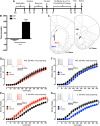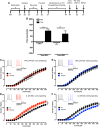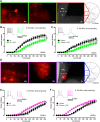Chemogenetic Excitation of Accumbens-Projecting Infralimbic Cortical Neurons Blocks Toluene-Induced Conditioned Place Preference
- PMID: 29317484
- PMCID: PMC5815347
- DOI: 10.1523/JNEUROSCI.2503-17.2018
Chemogenetic Excitation of Accumbens-Projecting Infralimbic Cortical Neurons Blocks Toluene-Induced Conditioned Place Preference
Abstract
Abuse rates for inhalants among adolescents continue to be high, yet preclinical models for studying mechanisms underlying inhalant abuse remain limited. Our laboratory has previously shown that, in male rats, an acute binge-like exposure to toluene vapor that mimics human solvent abuse modifies the intrinsic excitability of mPFC pyramidal neurons projecting to the NAc. These changes showed region (infralimbic; IL vs prelimbic; PRL), layer (shallow; 2/3 vs deep; 5/6), target (core vs shell), and age (adolescent vs adult) dependent differences (Wayman and Woodward, 2017). To expand these findings using reward-based models that may better mimic human drug abuse, we used whole-cell electrophysiology and drug receptors exclusively activated by designer drugs to examine changes in neuronal function and behavior in rats showing a conditioned place preference (CPP) to toluene. Repeated pairings of adolescent rats to binge concentrations of toluene vapor previously shown to enhance dopamine release in reward-sensitive areas of the brain produced CPP that persisted for 7 but not 30 d. Toluene-induced CPP was associated with increased excitability of IL5/6 mPFC neurons projecting to the core of the NAc and reduced excitability of those projecting to the NAc shell. No changes in PRL-NAc-projecting neurons were found in toluene-CPP rats. Chemogenetic reversal of the toluene-induced decrease in IL5/6-NAc shell neurons blocked the expression of toluene-induced CPP while manipulating IL5/6-NAc core neuron activity had no effect. These data reveal that alterations in selective mPFC-NAc pathways are required for expression of toluene-induced CPP.SIGNIFICANCE STATEMENT Disturbed physiology of pyramidal neurons projecting from the mPFC to the NAc has been shown to have different roles in drug-seeking behaviors for a number of drugs (e.g., methamphetamine, cocaine, ecstasy, alcohol, heroin). Here, we report that rats repeatedly exposed to the volatile organic solvent toluene, a member of the class of abused inhalants often used for intoxicating purposes by adolescents, induces a preference for the drug-paired environment that is accompanied by altered physiology of a specific population of NAc-projecting mPFC neurons. Chemogenetic correction of this deficit before testing prevented expression of drug preference. Overall, these findings highlight the importance of corticolimbic circuitry in mediating the rewarding properties of abused inhalants.
Keywords: DREADDs; core; electrophysiology; infralimbic; shell; volatile organic solvent.
Copyright © 2018 the authors 0270-6474/18/381462-10$15.00/0.
Figures





References
Publication types
MeSH terms
Substances
Grants and funding
LinkOut - more resources
Full Text Sources
Other Literature Sources
Medical
